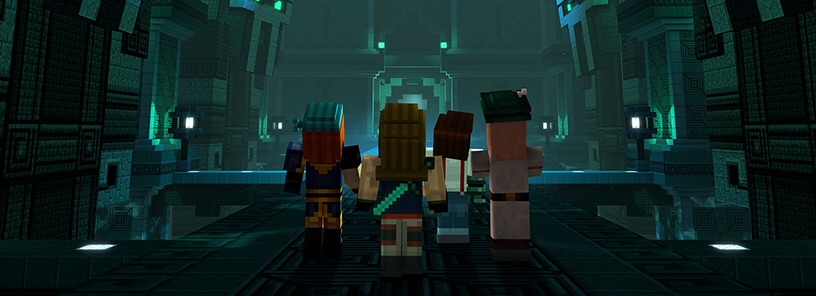
Markus ‘Notch’ Persson launched the biggest game in history using a game dev blog. You’ve probably heard of it before; it’s called Minecraft. Over 122 million copies have been sold, and it’s considered to be one of the best-selling games of all-time.
But here’s the interesting thing, he didn’t have to spend any money on advertising to generate buzz for Minecraft. Notch had built an entire community of dedicated fans, excited about the release of his upcoming game by merely documenting his development journey.
He started marketing early while he was creating the game by posting screenshots, YouTube videos, and updates on his Tumblr game dev blog. And it led to incredible success.
Through word-of-mouth, the news of a new open sandbox style game, where players get to build and create their world using 3D blocks had spread like wildfire. A lot of people were anticipating the launch of this game. So much, in fact, that almost one million copies of Minecraft had been sold before it was even out of beta.
Notch’s success is a perfect example of how indie developers on a limited budget can use something as simple as starting a game dev blog to not only market their game but build a whole community around it, way before its release.
Okay, I know what you’re thinking. That’s great, but it has to be more to it than just starting a game dev blog. And you’re absolutely right. Like the famous John Wooden quote goes, “It’s not what you do, but how you do it.”
So, let’s dig a little deeper by deconstructing Minecraft’s game dev blog.
Start with a Good Game Idea
Everything begins with an idea. Before Notch started documenting his game development journey, he had to come up with a great concept. It’s important to have an idea of what you’re going to do, beforehand. Notch was very strategic in the development and marketing of his game, which played a huge part in Minecraft’s success. He used the same technique that most of the top game developers and even entrepreneurs practice, to help come up with innovative ideas.
If you follow our blog, you’ve probably heard us mention this practice more than once. It’s the ‘Model and Improve’ technique, and it delivers results. In fact, on Notch’s game dev blog he openly, discusses how he ‘modeled and improved’ various elements from different games to create Minecraft.
The ‘model and improve’ technique is simple to follow. It’s all about inspiration. When using it for game concepts, you have to search for well-performing games that are similar to the concept you’re considering. Then you analyze the games by playing and studying the features and elements that stand out to you. Make a note of what the game excels at, and where it falls short. Once you have it written down, go back and try to think of new ways to improve and modify. The goal is to take a concept, make changes, and improve on it until you’ve brainstormed a completely new and unique idea.
The key to creating a successful game is to make it unique but rooted in familiarity. Modeling and improving is one of the easiest ways to accomplish this.
Notch used this technique to come up with the concept of Minecraft. When he turned to the indie scene in search of inspiration, the first game that got his attention was Dwarf Fortress. In Dwarf Fortress players must aide a clan of dwarf warriors on a mission to build and protect a fortress from roaming critters and supernatural creatures. It’s a simulation management game but with a twist. Dwarf Fortress is text-based with pixelated maps, numbers, symbols and an engrossing storyline that you have to read similar to a book.
When your camp is being attacked by a were-elephant, it’s up to players to imagine the scenario in their head. It’s definitely not everyone’s cup of tea. It’s been referred to by many, as one of the most complex games ever made. The complicated user interface and symbols create a steep learning curve, especially for players new to the genre.
However, Notch took the core concept of Dwarf Fortress and modeled and improved upon it. He made the game user-friendly, eliminated the overly complicated interface, and added graphics. In his game dev blog, he documented that he didn’t stop at Dwarf Fortress. He kept brainstorming for new ideas. Inspired by Dungeon Keeper’s first-person perspective, Notch tried to add that element to the game, but it wasn’t working. Then he stumbled across Infiniminer.
He states in his game dev blog, “My god, I realized that was the game I wanted to do. I played it in multiplayer for a while and had a blast, but found it flawed. Building was fun, but there wasn’t enough variation, and the big red/blue blocks were pretty horrible. I thought a fantasy game in that style would work really really well, so I tried to implement a simple first-person engine in that style, reusing some art and code.”
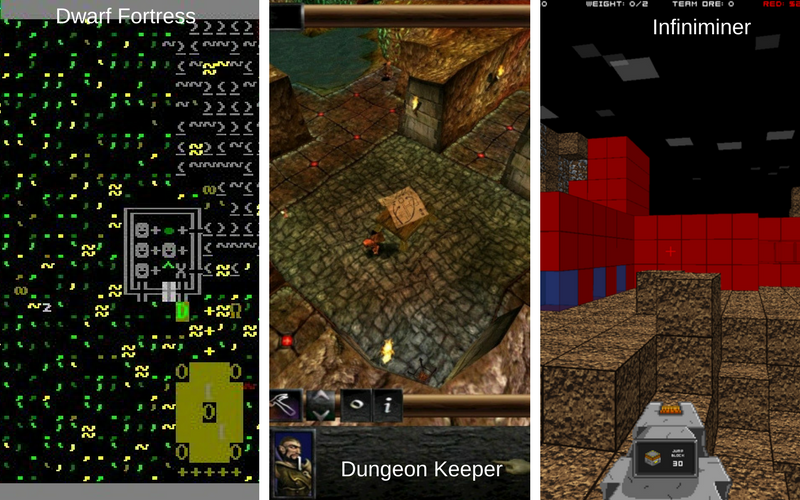 He took concepts from Dwarf Fortress, Dungeon Keeper, and Infiniminer. Then he used the ‘model and improve’ technique to create an entirely new game. After Markus Persson aka ‘Notch’ had his idea and the wheels turning, he came up with a plan on how he was going to develop and market his game.
He took concepts from Dwarf Fortress, Dungeon Keeper, and Infiniminer. Then he used the ‘model and improve’ technique to create an entirely new game. After Markus Persson aka ‘Notch’ had his idea and the wheels turning, he came up with a plan on how he was going to develop and market his game.
Plan Your Marketing Strategy Early
Your marketing should start as soon as your game development starts. It’s important for indie developers to get as much buzz as possible for their game before its launch. Being active in the indie scene and using a game dev blog to document your development process are two of the most effective ways to spread the word about your game.
Notch was fully aware of this when he started Minecraft. As a programmer and game enthusiast, he was already quite active on the indie game forums. TigSource forums was his favorite. He frequently read and discussed game development with other indie developers. Panels are great places for not only networking but learning about game design as well. You can ask questions, gain valuable feedback, and build relationships with other game creators.
Getting active in the gaming community is also a great way to connect with people who might be interested in reading your game dev blog. You can add value to the threads by sharing tips and insights with your peers and potential fans. Plus many forums allow you to post a link to your site and list your game dev blog in your bio or signature for additional exposure. Markus Persson was a regular on the forums and a very active member of TigSource. He would frequently share through the forum and ask for feedback about the development of Minecraft. In fact, the game’s name, Minecraft was chosen by the forum community at TigSource.
“When I started Minecraft I decided that I wanted to do everything in a very open and transparent way. That kind of stuck and so we now get lots of people talking directly to us, the developers, which I think has helped Minecraft go very viral,” said Markus in a 2012 interview with Bafta.
Having a plan in place for how you’re going to market your game during development is vital. Markus was already an active part of the indie game scene when he started his game dev blog. He had decided early on that he was going to use blogging and social media as tools to promote his game.
Now let’s take a closer look at Notch’s game dev blog and break down his set-up:
Setting Up Your Game Dev Blog
In 2009, Markus Persson aka Notch created a game dev blog for free on the microblogging site known as Tumblr. At the time, Tumblr was quickly growing in popularity. He named his Tumblr game dev blog The Word of Notch. It was a basic Tumblr blog, nothing fancy. There weren’t any particular themes or templates used. As you can see in the photos, featured above. Notch kept things simple and to the point.
So, how was he able to build a whole community merely blogging?
Well, Notch’s game dev blog was more than just a blog. It was the main headquarters or ‘home base’ for Minecraft. He used it as a springboard to promote his game through multiple channels. His game dev blog was also where he curated and organized all of his content and talked openly with his readers and potential players. It had a contact section with the question, ‘Want me to discuss something specific on the blog?’ The option gave readers the opportunity to connect and send feedback, both essential for establishing a following. But Notch didn’t just stop there. He used social platforms like YouTube and Twitter to cross-promote posts and generate buzz for the game. Notch also utilized his presence on the indie game forums and promoted in the threads. Sites like Reddit and Digg were probably used as well.
Using a growing platform with integrated social features like Tumblr helped him establish a solid foundation. Combined with the powerhouse of YouTube where he also posted his gameplay videos and sneak peeks, plus the use of other social sharing platforms, it was an effective strategy. During the whole process, Notch continued to be active in the forums as well, posting game development updates. All of these strategic actions played a significant role.
However, it’s more than just choosing the right platform and strategy that’ll determine your game dev blog’s success. Content and consistency are also crucial.
The posts in Notch’s game dev blog gave readers a small glimpse inside the life of the creator of Minecraft. He remained transparent while managing to keep the focus primarily on the development process. An excellent example of this is a post from May of 2009 where he wrote, “I had a bit of trouble falling asleep last night. It struck me that if I limited the range of light sources to just a few meters, I could quite possibly have dynamic lighting in the game.”
Many of the posts in the game dev blog were short updates with an exclusive screenshot or gameplay video to spark interest.
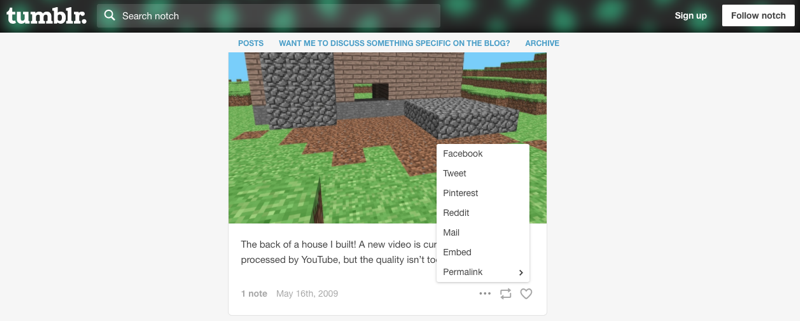 Other posts would often describe new features that he was working on or an annoying bug or glitch that was hard to solve.
Other posts would often describe new features that he was working on or an annoying bug or glitch that was hard to solve.
His game dev blog was also very consistent. Notch made an effort to post almost daily if possible. Consistency is key when blogging. It helps build up an audience. For a game dev blog to be successful, you should have a posting schedule in place. In our previous article on staying motivated, we discussed in-detail how scheduling out blocks of time to focus solely on your game is crucial. The same goes for blogging.
Posting with Passion
Another determining factor in the success of Notch’s game dev blog was his passion for what he was doing. Being passionate adds momentum to your marketing efforts. When you read ‘The Word of Notch’ you immediately can tell that he’s passionate about Minecraft. It comes through in his posts, progress updates, and interaction on social media. In the beginning, when his game dev blog didn’t have a huge following, he didn’t let it discourage him. He was passionate and focused on his goal of making a great game and documenting the process. It’s essential that you stay passionate as you develop your game. People will take notice. Remember, passion fuels success.
The Game Dev Blog Formula for Success
Notch created one of the most successful games in history, Minecraft. After analyzing the whole process, we now know exactly how he used a game dev blog to build an entire community of loyal fans. These strategies can also be used in your game development and marketing efforts.
Here are some of the Key Takeaways:
- Start with a great game idea. If your game idea isn’t good, it’ll be hard to get others excited about it. Use the ‘model and improve’ method to help brainstorm a unique idea.
- Start your marketing as soon as your game development begins.
- Make it a priority to be active in the indie scene. Join and participate in game dev forums. Connect, share, and seek feedback.
- Pick your platforms carefully. Try to choose one that’s popular with social features like Medium.
- Don’t just blog. Use social platforms like YouTube, Twitter, Facebook, Reddit, and others to cross-promote posts and generate buzz for your game.
- YouTube can be a powerful tool, create a YouTube channel to host and post videos and exclusive teasers.
- Use forums to promote your game dev blog.
- Focus on only a few platforms at once. Find your core three and slowly build up from there.
- Remember, content and consistency are important. Make your posts personal, but development focused. Follow a posting schedule to stay on track.
- Be passionate about making your game. It adds momentum and fuels success!

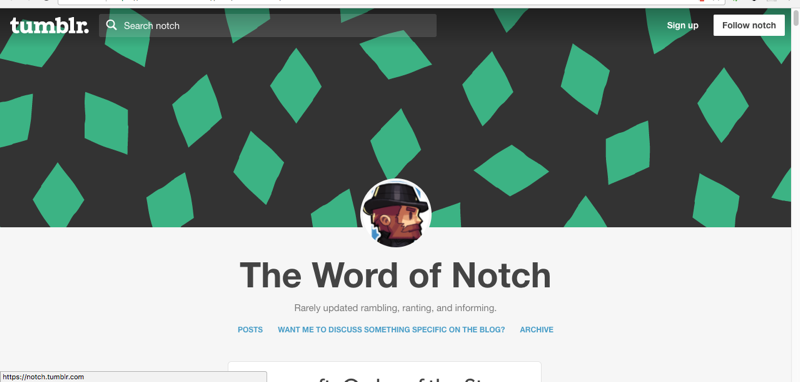
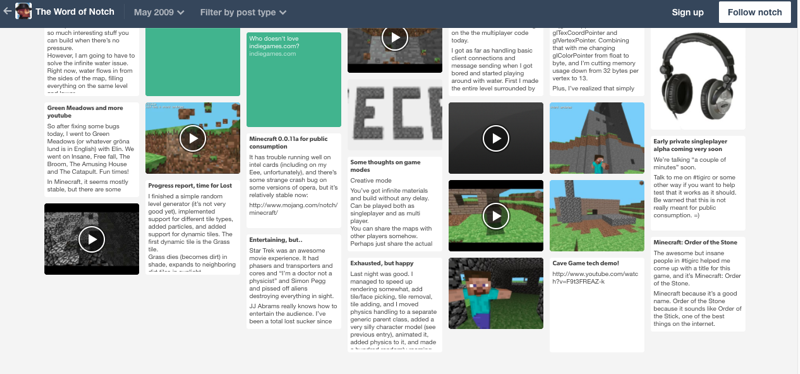



It’s definitely a great article! Creating and keeping up with a blog/devlog is a tough gig and requires constant upkeep and as a solo game dev it’s even tougher. But can be really rewarding with the support you get from everyone that reads and responds and eventually downloads your game.
[…] our previous post, ‘Deconstructing Minecraft’s Game Dev Blog,’ we broke down the strategies that Notch used for generating free buzz around his game. If you […]
Its so hard to come up and create your own game idea. Every time you think of something, either someone has already created it or they have something similar.